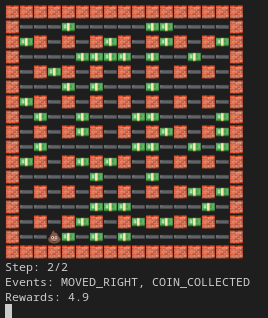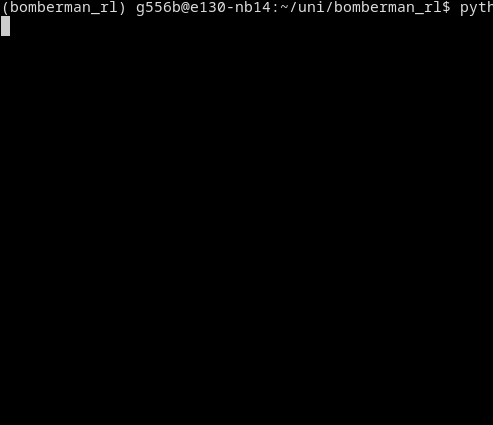Bombergym features a rewrite of the original bomberman_rl game engine in order to be compatible with OpenAI Gym. By providing a gym compatible environment of bomberman, we hope to make our lives a bit easier:
- We want to be able to quickly experiment and iterate on cutting edge RL algorithms - many Deep RL libraries, for example stable_baselines3, can simply be directly plugged into an existing gym environment.
- We can use the existing ecosystem and libraries to avoid having to write boilerplate. For example, we can use
make_vec_envfromstable_baselines3to create vectorized environments and train our agent in parallel without having to worry how to do this with the existing game engine. - We can make development and collaboration easier and more streamlined by clearly separating what makes up the environment (observation space, action space, rewards) and what makes up our reinforcement learning algorithm and training routines.
Also, we completely ripped out pygame, and replaced it with a CLI based rendering of the game. Makes debugging easier, the GPU I have is only accessible via ssh.
Installing: After activating whatever Python virtual env management, run pip install -r requirements.txt. Tested on Python 3.9. The underlying Bomberman-RL project requires Python 3.8+.
Testing: To run unit tests, run python -m unittest
Playing the game: To play the game in the terminal, run python main_gym_play.py. Requires some unicode support in your terminal (it's 2022). The 💩 is the agent. Vim Keybindings (h, j, k, l: movement, b: place a bomb, any other key: wait). We will show you rewards and also the observation space and events after each step.
We provide different versions of the bomberman game as environments. All Gym observation spaces are directly and purely computed from the original game_state provided to allow our model to plug into the original game again easily for the competition.
BomberGym-v0 is the most basic and naive environment. It is inspired by the gym classic control environments for Atari games, where simply the RGB values or even the 128-byte RAM is given as observation space. We simply translate the game_state into a 2-dimensional array (kind of like a RGB image version of the game, just more condensed):
>>> import gym
>>> from bombergym.scenarios import coin_heaven
>>> from bombergym.environments import register
>>>
>>> register() # Register our custom environments to gym
>>> settings, agents = coin_heaven() # Play in coin heaven scenario
>>>
>>> env = gym.make('BomberGym-v0', args=settings, agents=agents)
>>> env.reset()
array([[-2, -2, -2, -2, -2, -2, -2, -2, -2, -2, -2, -2, -2, -2, -2, -2, -2],
[-2, 0, 0, 0, 0, 0, 0, 0, 3, 0, 3, 0, 3, 0, 3, 3, -2],
[-2, 3, -2, 0, -2, 0, -2, 0, -2, 0, -2, 3, -2, 0, -2, 0, -2],
[-2, 0, 3, 0, 0, 0, 0, 3, 3, 3, 0, 0, 0, 0, 0, 0, -2],
[-2, 0, -2, 0, -2, 0, -2, 0, -2, 0, -2, 0, -2, 3, -2, 3, -2],
[-2, 3, 0, 0, 3, 0, 0, 3, 0, 0, 0, 3, 0, 0, 3, 0, -2],
[-2, 3, -2, 0, -2, 0, -2, 3, -2, 3, -2, 0, -2, 3, -2, 3, -2],
[-2, 0, 0, 0, 0, 0, 0, 3, 0, 0, 3, 0, 0, 0, 0, 0, -2],
[-2, 3, -2, 0, -2, 3, -2, 0, -2, 3, -2, 3, -2, 3, -2, 0, -2],
[-2, 3, 0, 0, 0, 0, 3, 0, 3, 0, 3, 0, 0, 0, 3, 0, -2],
[-2, 0, -2, 0, -2, 0, -2, 0, -2, 0, -2, 0, -2, 0, -2, 0, -2],
[-2, 3, 0, 3, 0, 3, 3, 0, 0, 0, 0, 0, 0, 3, 0, 0, -2],
[-2, 3, -2, 0, -2, 0, -2, 0, -2, 0, -2, 0, -2, 0, -2, 0, -2],
[-2, 0, 0, 3, 0, 0, 0, 0, 0, 0, 0, 0, 0, 0, 0, 0, -2],
[-2, 3, -2, 0, -2, 0, -2, 0, -2, 3, -2, 0, -2, 3, -2, 0, -2],
[-2, 0, 3, 0, 0, 3, 3, 0, 0, 3, 0, 0, 0, 3, 0, 2, -2],
[-2, -2, -2, -2, -2, -2, -2, -2, -2, -2, -2, -2, -2, -2, -2, -2, -2]])The array is simply a representation of the field as we see in the GUI, where the numbers have the following meanings:
EXPLOSION = -4
BOMB = -3
WALL = -2
ENEMY = -1
EMPTY = 0
CRATE = 1
SELF = 2
COIN = 3
So far, we have not achieved great results from this environment alone. Even when using an advanced RL policy. A reason could be that the Markov property is not entirely fulfilled here - the information of when a bomb will explode is not encoded. As such, the agent doesn't really learn how to not blow up.
The following rewards are defined for this environment (as in the original game scaffolding, they are based on events - the sum of all occuring events is returned as the step reward):
e.COIN_COLLECTED: 5,
e.INVALID_ACTION: -1,
e.KILLED_OPPONENT: 5,
e.SURVIVED_ROUND: 1,
e.MOVED_DOWN: -.1,
e.MOVED_LEFT: -.1,
e.MOVED_RIGHT: -.1,
e.MOVED_UP: -.1,
e.WAITED: -.3,
BOMB_FLED: 3,
WALKS_INTO_BOMB_RADIUS: -3,
AGENT_MOVED_OUT_OF_BOMB_TILE: 2
Notably, BOMB_FLED will reward the agent if it was in blast radius, but fled. WALKS_INTO_BOMB_RADIUS does the opposite. AGENT_MOVED_OUT_OF_BOMB_TILE tries to give an incentive to put a movement command after placing a bomb. The only thing we got from these events though, is an agent that will place a bomb, duck behind a corner, place another bomb, et cetera - exploiting the BOMB_FLED reward, but not making progress. So, probably not a great idea, but interesting nonetheless.
We have some preliminary promising results with BomberGym-v1.
>>> env=gym.make('BomberGym-v1', args=settings,agents=agents)
>>> env.reset()
Out[5]:
array([0. , 0. , 0. , 0. # bomb awareness
, 0. , 0. , 0. , 0. # explosion awareness
, 0. , 0. , 0. , 0. # crate awareness
, 0.07142857, 0. , 0. ,0.11111111 # coin awareness
, 0. , 0. , 0. , 0. # enemy awareness
, 1. , 0. , 0. , 1. # wall awareness
, 0. # is a bomb under me?
])
Awareness features are 1 divided by the tile distance to a certain thing in any direction. 4 features for a given thing, left, right, top, bottom. With this, we can solve coin_heaven, but slow: literally only encodes the line of sight of the agent, so has to spend a long time randomly searching once a "signal" to a coin is lost.
Rewards given:
e.COIN_COLLECTED: 5,
e.INVALID_ACTION: -1,
e.KILLED_OPPONENT: 5,
e.SURVIVED_ROUND: 1,
e.MOVED_DOWN: -.1,
e.MOVED_LEFT: -.1,
e.MOVED_RIGHT: -.1,
e.MOVED_UP: -.1,
e.WAITED: -.3,
Codename: Manhattan
We like how BomberGym-v1 performs and is able to solve the coin-heaven without big problems. However, it's just too damn slow - python-pathfinding is the main reason, and also our implementation is far from optimal. Can we do better? Turns out - replacing the complicated pathfinding algorithm with the manhattan distance, and keeping everything else the same converges to the same reward - and we can process 300 frames per second again instead of 3 frames per second in the pathfinding variant. Quite unexpected!
Codename: Manhattan V2
In BomberGym-v2 we didn't play with rewards. In particular, in the rewards until
now a suicide penalty is missing. We address this in this environment.
Everything else is the same to BomberGym-v2 (I think, gotta check it again)
e.COIN_COLLECTED: 5,
e.INVALID_ACTION: -1,
e.KILLED_OPPONENT: 10,
e.SURVIVED_ROUND: 10,
e.KILLED_SELF: -10,
e.MOVED_DOWN: -.5,
e.MOVED_LEFT: -.5,
e.MOVED_RIGHT: -.5,
e.MOVED_UP: -.5,
e.WAITED: -.8,
e.CRATE_DESTROYED: 3,
e.BOMB_DROPPED: -1,
(Todo, put in report) Using the BomberGym-v2 (and v1, v3) experiments we successfully applied proximal policy optimization based reinforcement learning and are able to solve the coin-heaven subtask. However, we did not achieve convergence for the classic scenario, even in simplified form without any enemies.
Orange Lane: v1 (only local vision) - Episode length is much longer. Blue Line (v2 pathfinding) - Lowest Episode length ==> best pathfinding characteristic of agent. Red line (v3 manhattan) - Slightly higher episode length but converges close to pathfinding version while being orders of magnitude faster to compute (see FPS graph)
Figure x shows mean episode length against number of iterations.
Figure y shows mean cumulative reward gained against number of iterations.
Figure z shows mean iterations per second while training the reinforcement learning algorithm. The time measured includes the time required to update the game as well as the time required to optimize the policy.
Codename: Cnnboard
Back to the roots - similar to plain boards, but different channels conveying different information, like r,g,b channels in image, grid,danger,enemy,coin,crate channel - put into CNN. Collect data with rule-based agent and injected randomness. Try to teach a CNN to play like rule_based agent in a supervised setting. Some promising results so far. Idea: can we use this as pretraining, and then fine tune our results with Deep-Q Atari Deepmind approach? Todo.
Using a few tricks and basic supervised training, we can at least get something that kind of works (except for complete failure at the end, but we didn't train this one very long:)
Codename: Cnnboard-v2
Based on successes of cnnboard, we try to incorporate more temporal information in the current game state. The agent input plane of the cnnboard will leave "breadcrumbs": values decaying to zero indicating the agents previous positions. With this we easily reach the performance of rule_based_agent and we don't have the bombergym-v4 problem where the agent randomly is stuck in the loop some times, like in the gif above. New last minute idea: take our best model, and now train online. selective experience replay. encourage more coin collection. discourage getting stuck in a corner where we can be exploded. Possible ablation experiment: Breadcrumb duration. Currently set to 3, i.e. last 3 agent moves are encoded in agent plane.

